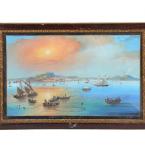


















Neapolitan School 19th
Century,
Naples From The Sea, Gouache On Paper
Height: 13
Width: 19

SOLD
Seascape Painting
Oil on Canvas by William Lester Stevens American Artist Sea LA . A beautiful
Seascape artwork by William Lester Stevens oil on canvas. " At the Docks,
Gloucester ", 1888-1969.
Overall Good
condition. under blue light shows darker stretch sign of inpainting or
retouching into a small area usually used to conceal a tear in a canvas that
has been patched on the reverse, yet when we checked the back of the canvas it
didn't show patching on back side area , which means it was not for covering a
tear. so possibly simple inpainting.
under a black light
and ultraviolet light in a dark room we examined the surface under the black
light to see if any areas of the paint fluoresce differently, as you see in the
pictures the Older paint looks different from new paint which shows a very small
surface of new paint that looks darker by the boat front area.
possibly minor
Craquelure lines in the paint layer it was not visible to me, but you can check
it yourself if you wish. We didn't notice paint loss or water damage and it
doesn't show visible surface dirt but removing it from the frame, it shows that
it has accumulated on the top edges and along the lip, even though it didn't
affect the vibrant colors of this beautiful painting. No signs of overcleaning
or fading or varnish discoloration. it doesn't show that the canvas has been
re-lined by looking carefully at the edges , i couldn't see another piece of
canvas that has been sandwiched to the back it if, and i didn't find any wax or
glue residue. you can have your expert check it out. No signs of looseness or
sagging. Minor tears to the edges ,rubbing at the edges of the canvas as seen
in the pictures scattered abrasion. We have over 60 pictures and a few videos
to share with you, you are welcome to send your expert. Sold As is.
The absence of a
condition statement does not imply that the lot is in perfect condition or
completely free from wear and tear, imperfections or the effects of aging. To
sending your expert to create an independent Condition report , by appointment
only at la maison francaise antiques. Any condition statement given, as a
courtesy to a client, is only an opinion and should not be treated as a
statement of fact. Lamaisonfrancaise, Inc. shall have no responsibility for any
error or omission.
William Lester
Stevens
Born in Rockport,
Massachusetts, Stevens received his initial art training from Parker Perkins, a
local marine painter who charged him fifty cents an hour. He later spent four
years at Boston's Museum of Fine Arts School, where he studied under Edmund Tarbell,
among others. Although influenced by Tarbell, Stevens' wide range of
brushstrokes and impressionist style prevented him from being classified as a
"Tarbellist," as many of Tarbell's followers were labeled.
Stevens joined the
Army in 1917 and was sent to Europe where he continued to paint and sketch.
Upon his return to the United States, he was pleased to discover that Rockport
had become a popular haven for artists. Though he was the only native son among
them, such well-known painters as Frank Duveneck, Childe Hassam, Leon Kroll and
Jonas Lie also recorded the scenery of Rockport, Cape Ann and Gloucester. In
1921, together with fifty other artists, Stevens founded the Rockport Art
Association, primarily to plan exhibitions of the work of outstanding area
artists.
Throughout the
course of his long career, Stevens taught, first in Rockport, then at Boston
University (1925-1926) and Princeton (1927-1929). He later gave lessons and
held one-man shows in Charlotte and Asheville, North Carolina, where his work
was well-received. Southerners particularly enjoyed his views of famous
Southern gardens and cities.
Though the
Depression years were difficult for both the artist and his family, the 1930s
did bring Stevens some measure of commercial and personal success. He did a
number of covers for The American Legion Magazine and won prizes in New Haven,
Springfield and Rockport. In 1934, he abandoned Rockport to the growing tourist
population and moved to Springfield, and then to Conway, Massachusetts, where
he remodeled an old farmhouse and constructed a studio which looked north
towards Mount Monadnock. Except for summer trips made in the 1960s to Lubec,
Maine, Campobello Island and Grand Manan Island, Stevens lived and painted in
Conway for the rest of his life.
Primarily an oil
painter, Stevens also used watercolor and acrylics. Although he was proficient
in all three, oils allowed him greater versatility; more significantly, Stevens
simply liked oils better. A superb craftsman, Stevens painted rapidly and with
assurance, but always took time to find the best vantage point. He understood
the importance of placing himself where he could create the best composition
and "took the liberty of moving objects so that the composition would meet
his desires." This is perhaps why Stevens would later conclude that
"fine pictures are the result of fine minds (Greenfield, p. 13).
Stevens continued to
create views of New England until almost the final day of his life, June 10,
1969. He died in Conway, Massachussetts.














